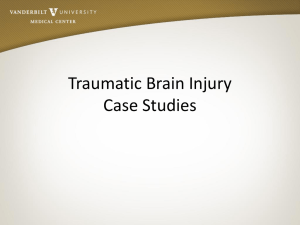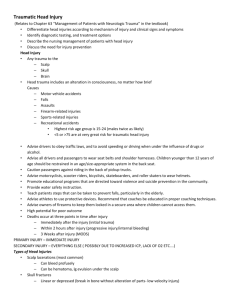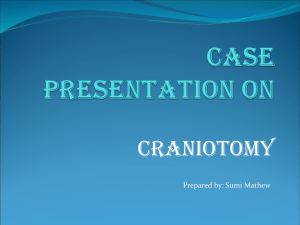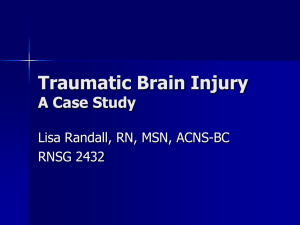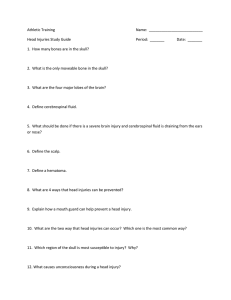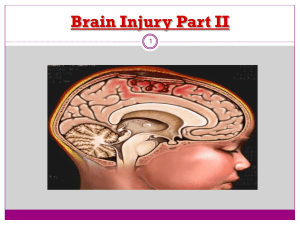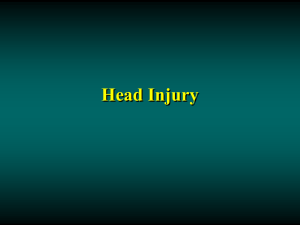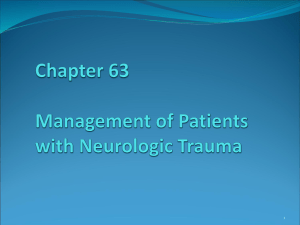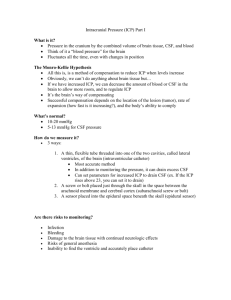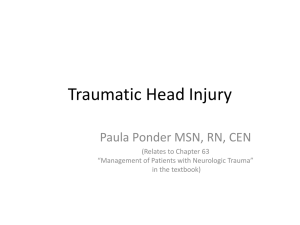Head trauma: Book reading
advertisement
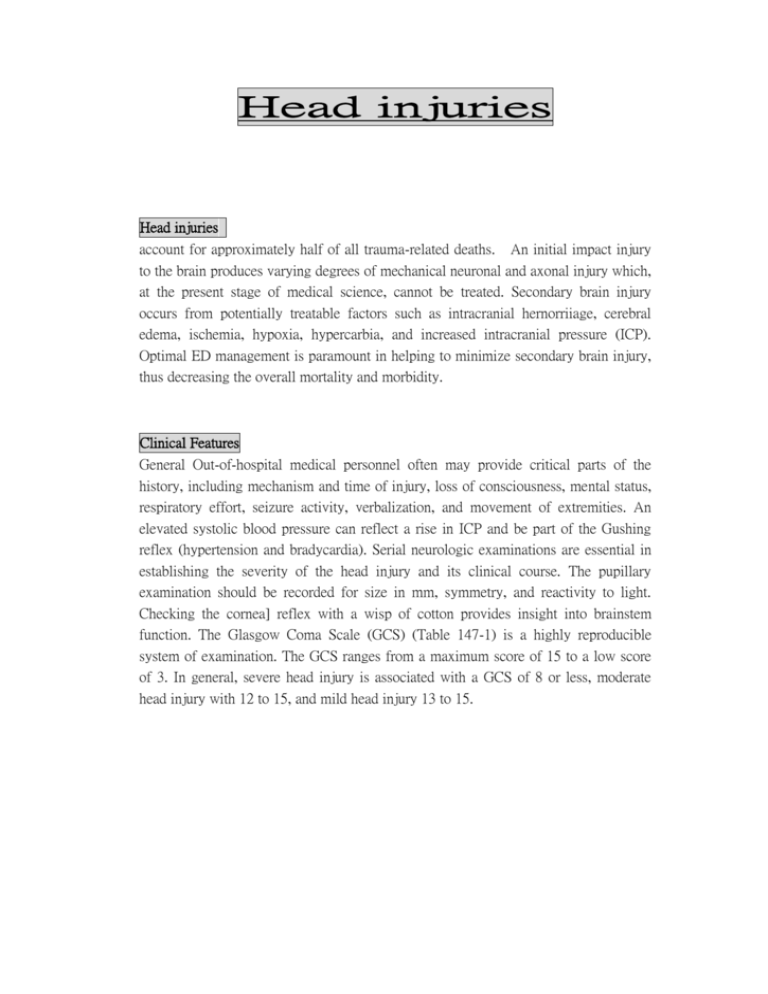
Head injuries Head injuries account for approximately half of all trauma-related deaths. An initial impact injury to the brain produces varying degrees of mechanical neuronal and axonal injury which, at the present stage of medical science, cannot be treated. Secondary brain injury occurs from potentially treatable factors such as intracranial hernorriiage, cerebral edema, ischemia, hypoxia, hypercarbia, and increased intracranial pressure (ICP). Optimal ED management is paramount in helping to minimize secondary brain injury, thus decreasing the overall mortality and morbidity. Clinical Features General Out-of-hospital medical personnel often may provide critical parts of the history, including mechanism and time of injury, loss of consciousness, mental status, respiratory effort, seizure activity, verbalization, and movement of extremities. An elevated systolic blood pressure can reflect a rise in ICP and be part of the Gushing reflex (hypertension and bradycardia). Serial neurologic examinations are essential in establishing the severity of the head injury and its clinical course. The pupillary examination should be recorded for size in mm, symmetry, and reactivity to light. Checking the cornea] reflex with a wisp of cotton provides insight into brainstem function. The Glasgow Coma Scale (GCS) (Table 147-1) is a highly reproducible system of examination. The GCS ranges from a maximum score of 15 to a low score of 3. In general, severe head injury is associated with a GCS of 8 or less, moderate head injury with 12 to 15, and mild head injury 13 to 15. Skull fractures Isolated linear nondepressed fractures with intact scalp do not require treatment. Life-threatening intracranial hemorrhage may result, however, if the fracture causes disruption of the middle meningeal artery or a major dural sinus. Depressed skull fractures are classified as open or closed, depending on the integrity of the overlying scalp. Although basilar skull fractures can occur at any point in the base of the skull, the typical location is in the petrous portion of the temporal bone. Findings associated with a basilar skull fracture include hemotympanum, otorrhea or rhinorrhea, periorbital ecchymosis (raccoon eyes), and retroauricular ecchymosis (Battle sign). Brain concussion Concussion is a diffuse head injury associated with transient loss of consciousness that occurs immediately following a nonpenetrating blunt impact to the head. It generally occurs when the head, while moving, strikes or is struck by an object. The duration of unconsciousness is typically brief (sec-min). Complete recovery is typical, although persistent headache and problems with memory, anxiety, insomnia, and dizziness can continue in some patients for wks after the injury. Brain contusion Common locations for contusions are the frontal poles, the subfrontal cortex, and the anterior temporal lobes. Contusions may occur directly under the site of impact or on the contralateral side (contrecoup lesion). The contused area is usually hemorrhagic with surrounding edema and is occasionally associated with subarachnoid hemorrhage. Neurologic dysfunction may be profound and prolonged, with patients demonstrating mental confusion, obtundation, or coma. Focal neurologic deficits may be present. Intracerebral hemorrhage Parenchymal hemorrhage result from lacerated blood vessels. Combination of parenchymal hemorrhage and contusion can produce an expanding mass lesion; when present in the anterior temporal lobe, uncal hemiation can occur without a diffuse increase in ICP. Physical findings are often similar to patients with severe contusions. Epidural hematoma Epidural hematoma results from an acute collection of blood between the inner table of the skull and dura. Approximately 80 of the time, it is associated with a skull fracture that lacerates a meningeal artery, most commonly the middle meningeal artery. Underlying injury to the brain may not necessarily be severe. In a classic scenario, the patient may present with clear mentation, the lucid interval, and then begin to develop mental status deterioration in the ED. A fixed and dilated pupil on t signifying he side of the lesion with contralateral hemiparesis are classic late findings. Subdural hematoma A subdural hematoma, a collection of venous blood between the dura and overlying the arachnoid and brain, results from tears of the bridging veins that extend from the subarachnoid space to the dural venous sinuses. A common mechanism is sudden acceleration-deceleration. Patients with brain atrophy, such as alcoholics or the elderly, are more susceptible to a subdural hematoma. Acute subdural hematomas become symptomatic within 24 h of injury. Symptoms may range from a headache to lethargy or coma. It is important to distinguish between acute and chronic subdural hematomas by history, physical exam, and CT scan. Penetrating injuries Gunshot wounds and penetrating sharp objects can result in penetrating injury to the brain. The degree of neurologic injury will depend on the energy of the missile, whether the trajectory involves a single or multiple lobes or hemispheres of the brain, the amount of scatter of bone and metallic fragments, and whether a mass lesion is present. Herniation Diffusely or focally increased ICP can result in hemiation of the brain at several locations. Transtentorial (uncal) hemiation occurs when a subdural hematoma or temporal lobe mass forces the ipsilateral uncus of the temporal lobe through the tentorial hiatus into the space between the cerebral peduncle and the tentorium. This results in compression of the oculomotor nerve and parasympathetic paralysis of the pupil on the same side, causing it to .become fixed and dilated. The cerebral peduncle is simultaneously compressed, resulting in contralateral hemiparesis. The increased ICP and brainstem compression result in progressive deterioration in the level of consciousness. Occasionally the contralateral cerebral peduncle is forced against the free edge of the tentorium on the opposite side, resulting in paralysis ipsilateral to the lesion-a false localizing sign. The posterior cerebral artery can be compressed against the free edge of the tentorium, resulting in infarction of the occipital lobe. If the hemiation continues untreated, there is progressive brainstem deterioration leading to hyperventilation, decerebration, and to apnea and death. Cerebellar tonsillar hemiation through the foramen magnum occurs much less frequently. Resultant medullary compression causes bradycardia, respiratory arrest, and death. Cingulate or subfalcial herniation occurs when one cerebral hemisphere is displaced underneath the falx cerebri into the opposite supratentorial space. This is rarely clinically diagnosed.
